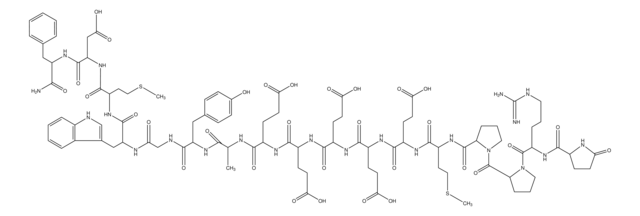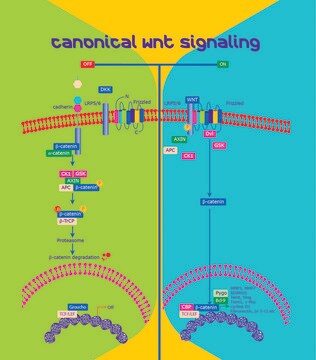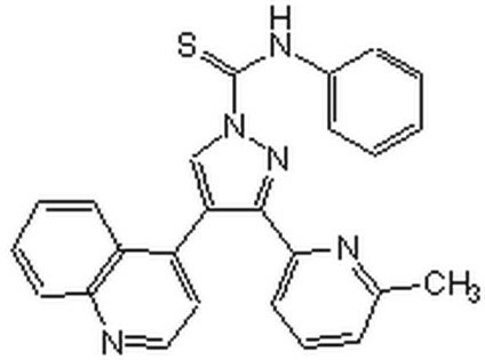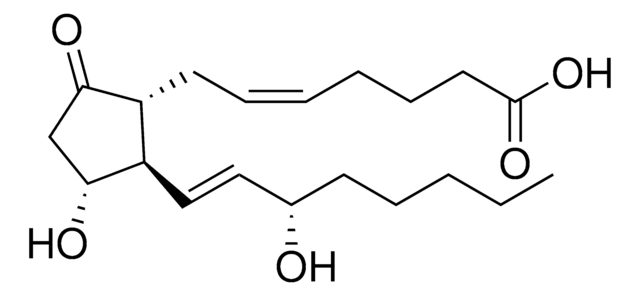SCP0152
Gastrin I (1-14)
≥92% (HPLC)
Iniciar sesiónpara Ver la Fijación de precios por contrato y de la organización
About This Item
Fórmula empírica (notación de Hill):
C79H100N16O27
Peso molecular:
1705.73
Código UNSPSC:
51111800
NACRES:
NA.32
Productos recomendados
Análisis
≥92% (HPLC)
formulario
lyophilized
composición
Peptide Content, ≥75%
condiciones de almacenamiento
protect from light
temp. de almacenamiento
−20°C
Amino Acid Sequence
Glp-Gly-Pro-Trp-Leu-Glu-Glu-Glu-Glu-Glu-Ala-Tyr-Gly-Trp
Descripción general
Gastrin, a classic digestive hormone, is found in three major forms: gastrin-34 (big gastrin), gastrin-17 (little gastrin), and gastrin-13 (minigastrin). Mammalian gastrin consists of a C-terminal four amino-acid sequence and a sulfated tyrosine 7 residue from the C-terminus. Gastrin is mostly found in the G cells of the stomach mucosa. Nutrients and gastrin-releasing peptides stimulate the release of gastrin.
Aplicación
Gastrin I (1-14) has been used:
- as a component of gastric cancer stem/progenitor cell (GCSPC) medium for tumorsphere culture
- as a supplement in organoid growth medium (OGM) for patient-derived organoid (PDO)
- in viable lymphocytes culture for re-stimulation assay
Acciones bioquímicas o fisiológicas
Gastrin is a linear polypeptide that induces the secretion of gastric acid (HCl) by parietal cells.
The peptide gastrin I (1-14), which lacks a basic site, forms positive ions. Gastrin promotes the production and liberation of histamine in enterochromaffin-like cells through cholecystokinin 2 receptor (CCK2R). It also stimulates the release of gastric acid in parietal cells via the CCK2R receptor. Gastrin plays a key role in Zollinger-Ellison syndrome. It may play a role in the development of colorectal carcinoma.
Código de clase de almacenamiento
11 - Combustible Solids
Clase de riesgo para el agua (WGK)
WGK 3
Punto de inflamabilidad (°F)
Not applicable
Punto de inflamabilidad (°C)
Not applicable
Certificados de análisis (COA)
Busque Certificados de análisis (COA) introduciendo el número de lote del producto. Los números de lote se encuentran en la etiqueta del producto después de las palabras «Lot» o «Batch»
¿Ya tiene este producto?
Encuentre la documentación para los productos que ha comprado recientemente en la Biblioteca de documentos.
Los clientes también vieron
C M Thorburn et al.
Gastroenterology, 115(2), 275-280 (1998-07-25)
Gastrin is a putative promoter of colorectal carcinomas. The aim of this study was to evaluate the temporal relationship between gastrinemia and development of colorectal malignancy. We conducted a nested case-control study among 128,992 subscribers to a health maintenance program
Zhi-Feng Miao et al.
Stem cells (Dayton, Ohio), 32(12), 3062-3074 (2014-08-22)
Peritoneal dissemination is the most common cause of death in gastric cancer patients. The hypoxic microenvironment plays a major role in controlling the tumor stem cell phenotype and is associated with patients' prognosis through hypoxia-inducible factor-1α (HIF-1α), a key transcriptional
Nicholas Osborne et al.
Cancer immunology, immunotherapy : CII, 68(10), 1635-1648 (2019-09-25)
Pancreatic cancer has been termed a 'recalcitrant cancer' due to its relative resistance to chemotherapy and immunotherapy. This resistance is thought to be due in part to the dense fibrotic tumor microenvironment and lack of tumor infiltrating CD8 + T cells. The
Junjie Gao et al.
Rapid communications in mass spectrometry : RCM, 22(24), 4066-4072 (2008-11-21)
Negative ion production from peptides and proteins was investigated by matrix-assisted laser desorption/ionization time-of-flight (MALDI-TOF) mass spectrometry. Although most research on peptide and protein identification with ionization by MALDI has involved the detection of positive ions, for some acidic peptides
F L Lai Benjamin et al.
Advanced functional materials, 30(48) (2021-03-12)
Tumor progression relies heavily on the interaction between the neoplastic epithelial cells and their surrounding stromal partners. This cell cross-talk affects stromal development, and ultimately the heterogeneity impacts drug efflux and efficacy. To mimic this evolving paradigm, we have micro-engineered
Nuestro equipo de científicos tiene experiencia en todas las áreas de investigación: Ciencias de la vida, Ciencia de los materiales, Síntesis química, Cromatografía, Analítica y muchas otras.
Póngase en contacto con el Servicio técnico
![[Leu15]-Gastrin I human ≥95% (HPLC)](/deepweb/assets/sigmaaldrich/product/structures/153/342/d4cb3dd7-13f1-46cf-8d1f-3907a5de7a83/640/d4cb3dd7-13f1-46cf-8d1f-3907a5de7a83.png)












